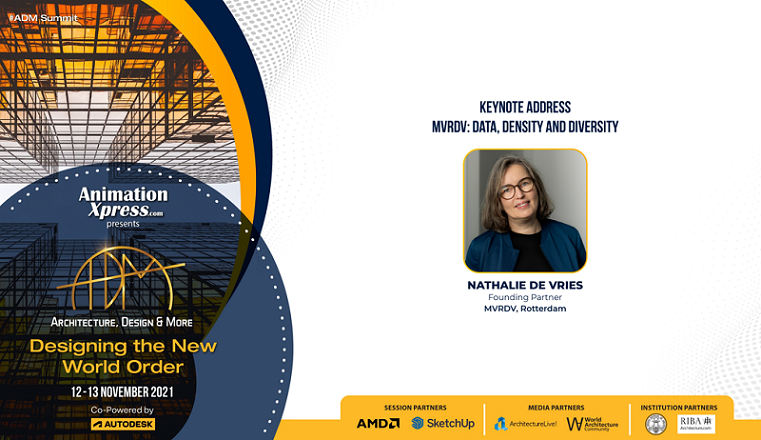Day two of the ADM Summit 2021 included an absorbing keynote address on the topic – ‘MVRDV: Data, Density and Diversity’ by MVRDV (Rotterdam) founding partner Nathalie De Vries.
At MVRDV, architecture is driven by a desire for better cities, pleasant work environments, engaging leisure facilities, and much-loved public amenities. Led by research-based experimentation, the organization focuses on the pragmatic needs of their clients and try to see every constraint as an opportunity to exploit in the creation of better buildings. As the ‘DV’ of MVRDV, Nathalie has led many successful MVRDV projects, with a focus on the invention of new building typologies and the creation of changeable, open systems.
Diving straight into the session’s theme, Nathalie expounded, “Data, density, and diversity: these three D’s are the drivers of design. Data is everywhere and it is in everything. We are using it and it is also partly using us. Therefore, we have to be critical about it. Density is important since the majority of the world’s population nowadays is living in cities, which in turn decides how agreeable and nice our lives would be. Diversity is exceptionally significant too. As individuals and humans, we have our own common needs. Hence, it is imperative to speak for those who cannot speak for themselves.”
Architectural construction comes with its own challenges and as responsible architects, we should keep in mind the five trends that will shape the construction and capital project. These are: future-proof designing and construction, intelligent asset management and decision-making, digital collaboration and mobility, designing platforms for the future, and rapid mapping and estimating.
Worldwide urbanization brings seemingly inescapable and uncontrollable forms of densification with it. Nathalie shared that in the current global context, cities occupy two per cent of the total land. Other statistics say 70 per cent is occupied by the economy, over 60 per cent by global energy consumption, there is 70 per cent greenhouse emissions, and 70 per cent global waste.
Hence, it is crucial to develop prosperity instead of growth. National governments should take responsibility for the quality of cities. And as architects, some of our goals for sustainable development should be – no poverty, zero hunger, good health and well-being, quality education, gender equality, and climate action.
Citing personal example, Nathalie asserted, “Our office has 270+ employees and 30+ nationalities. Only because our office is a representative for the society as a whole, we can reach incredible diverse ambitions. We should be honest and truthful to all the information we are using as designers to make our designs better.”
Well, let us all resort to using environmentally-conscious design techniques, which is the only way to venture into a world that entails a new kind of sustainable architecture. Once we achieve this, we’ll be able to say that the future is finally here.


